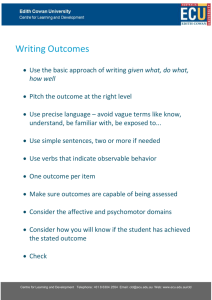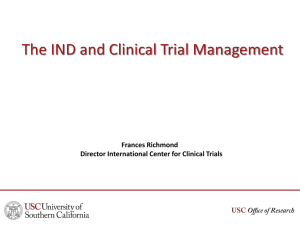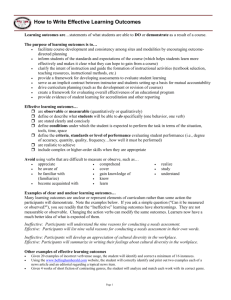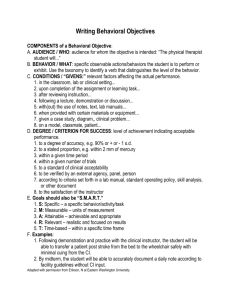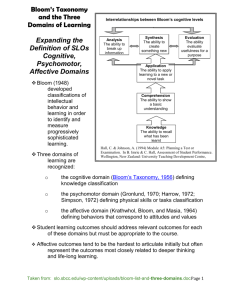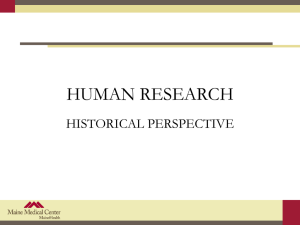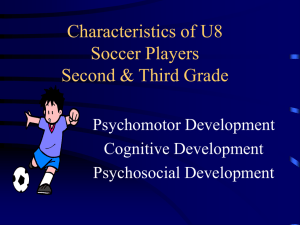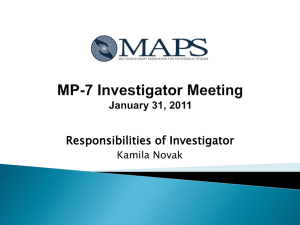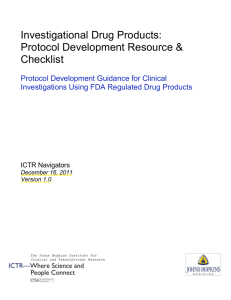Competencies
advertisement
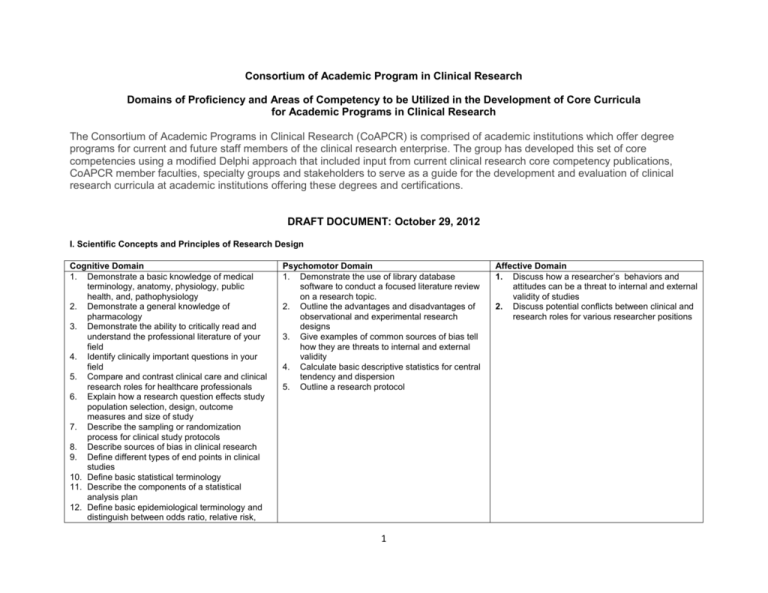
Consortium of Academic Program in Clinical Research Domains of Proficiency and Areas of Competency to be Utilized in the Development of Core Curricula for Academic Programs in Clinical Research The Consortium of Academic Programs in Clinical Research (CoAPCR) is comprised of academic institutions which offer degree programs for current and future staff members of the clinical research enterprise. The group has developed this set of core competencies using a modified Delphi approach that included input from current clinical research core competency publications, CoAPCR member faculties, specialty groups and stakeholders to serve as a guide for the development and evaluation of clinical research curricula at academic institutions offering these degrees and certifications. DRAFT DOCUMENT: October 29, 2012 I. Scientific Concepts and Principles of Research Design Cognitive Domain 1. Demonstrate a basic knowledge of medical terminology, anatomy, physiology, public health, and, pathophysiology 2. Demonstrate a general knowledge of pharmacology 3. Demonstrate the ability to critically read and understand the professional literature of your field 4. Identify clinically important questions in your field 5. Compare and contrast clinical care and clinical research roles for healthcare professionals 6. Explain how a research question effects study population selection, design, outcome measures and size of study 7. Describe the sampling or randomization process for clinical study protocols 8. Describe sources of bias in clinical research 9. Define different types of end points in clinical studies 10. Define basic statistical terminology 11. Describe the components of a statistical analysis plan 12. Define basic epidemiological terminology and distinguish between odds ratio, relative risk, Psychomotor Domain 1. Demonstrate the use of library database software to conduct a focused literature review on a research topic. 2. Outline the advantages and disadvantages of observational and experimental research designs 3. Give examples of common sources of bias tell how they are threats to internal and external validity 4. Calculate basic descriptive statistics for central tendency and dispersion 5. Outline a research protocol 1 Affective Domain 1. Discuss how a researcher’s behaviors and attitudes can be a threat to internal and external validity of studies 2. Discuss potential conflicts between clinical and research roles for various researcher positions hazards ratio and attributable risk 13. Identify appropriate information sources for a review of literature 14. Explain what is meant by evidence based medicine 15. Explain the difference between systematic reviews and meta-analyses 16. Critically analyze and discuss study results 17. Define comparative effectiveness research, outcomes research and health services research II. Medical Product Development Cognitive 1. Discuss the history of governmental regulation of drug, biologics, devices and food 2. Interpret significant historical clinical research laws and guidelines 3. Describe the roles of sponsors, partners and stakeholders in medical product discovery 4. Define and distinguish between the different centers and offices of the U.S. FDA: especially CBER, CDER, CFSAN, and CDRH 5. Explain the organization and structure of the EMA and other international regulatory agencies 6. Describe the International Conference on Harmonization (ICH), the process for its development, and its impact on global clinical research 7. Compare the clinical processes which lead to drug and device approvals 8. Describe all four phases of drug development 9. Discuss good Laboratory Practices (GLP) and GCP regulation for the preclinical and premarketing phases 10. Describe the IDE process 11. Identify reimbursement issues related to device development 12. Discuss issues for combined drug, biologic and device studies 13. Identify all pertinent regulatory authorities and organizations which develop standards for Psychomotor 1. Locate, explore and discuss content of websites for FDA departments (CBER, CDER, CFSAN, and CDRH) and ICH, EMA and other international regulatory agencies 2. Apply regulations for a mock study using a product that has a combination of drug, device and biologic. 2 Affective 1. Appreciate the differences between country regulations 2. Discuss potential conflicts in product development in cross-national studies drugs, biological, and devices 14. Define efficacy, safety and effectiveness 15. Explain the difference between quality control and quality assurance 16. Describe post-marketing studies and safety reporting systems 17. Describe pharmacovigilance planning 18. Describe the global expansion of clinical research and the issues relating to the conduct of global clinical trials 19. Describe the difference between prescription drug advertising and nonprescription drug advertising 20. Describe what orphan drugs are and discuss appropriate uses 21. Identify typical stakeholder cycle in the drug development process (i.e., consumers, drug company, non-governmental organizations, manufacturers, pharmacies, etc.) III. Ethical Considerations and the Responsible Conduct of Clinical Research Cognitive 1. Describe the significance of historical abuses on the evolution on principles of human subject protection in clinical research 2. Identify the key documents relating to the ethical conduct of clinical trials 3. Describe strategies for fairness in recruiting participants and distribution of benefits and burdens in clinical research 4. Describe the mission, function and procedures of the institutional review board/ethics committee 5. Describe the informed consent process for adults, children and vulnerable populations 6. Discuss requirements for privacy protection 7. Identify programs developed by the Council for International Organizations of Medical Sciences (CIOMS) 8. Describe responsibility of researchers in addressing health inequities, disparities and involvement of vulnerable populations Psychomotor 1. Conduct an internet search to identify past and current ethical abuses in clinical research. 2. Provide documentation of GCP and IRB certification from CITI 3 Affective 1. Discuss the historical and cultural perspectives which relate to human subject protection 2. Describe the ethical issues involved in the recruitment of vulnerable research participants 3. Discuss barriers and facilitators of informed consenting 4. Identify and discuss evolving ethical conflicts based on issues related to genetics, internet, community, gender, students and race/ethnicity in research. 9. Describe appropriate considerations for standards of care, tissue banking, and dissemination of research results IV. Clinical Study Operation and Regulatory Compliance Cognitive 1. Describe the roles and responsibilities of the various clinical investigation participants (investigators, institutions, government, private sites, and pharmaceutical industry, patients, health care consumers) as determined by Good Clinical Practice guidelines 2. Evaluate Clinical Trial Design, conduct and documentation required for compliance with ICH GCP’s 3. Identify the content that must be included on the various forms required by the FDA for IND and NDA submissions 4. Compare and contrast the similarities and differences between US FDA regulations, ICH Good Clinical Practices and the European Clinical Directive 5. Describe how study populations are specified in a clinical research protocol 6. Compare the regulatory requirements for protection of human subjects as described in Titles 21 and 45 of the US Code of Federal Regulations 7. Differentiate between regulations and guidelines 8. Discuss the financial disclosure requirements of investigators 9. Discuss HIPAA and its relevance to clinical research 10. Describe the regulatory requirements and elements of an informed consent document 11. Describe requirements for ensuring proper collection and processing of clinical research specimens 12. Describe IND safety reports 13. Describe drug accountability requirements 14. Distinguish between adverse events and Psychomotor 1. Complete an FDA Form 1571 and 1572, and assemble required documents that accompany each. 2. Prepare a diagrammatic representation of the organization of the ICH Common Technical Document 3. Obtain HIPAA compliance certification from available public or institutional online training courses 4. Assess a study protocol for feasibility as related to sponsor and site requirements 5. Match adverse events to MEDRA reporting terminology 6. Develop a site response to an FDA 483 letter and an associated SOP/training plan. 7. Screen sample patient records for inclusion in a mock study protocol 4 Affective 1. Discuss case studies that identify privacy issues in clinical research serious adverse events 15. Identify the basic types of post-marketing alert reports 16. Describe the role of the Data Safety Monitoring Board 17. Describe MEDRA and other database systems that can help identify safety signals 18. Differentiate between sponsor audits and regulatory inspections 19. Evaluate a FDA warning letter, and identify appropriate corrective action 20. Describe Phase IV marketing studies 21. Discuss the regulatory approach to developing and registering combination products 22. Describe the FDA’s accelerated Drug Approval/Expanded Access Programs V. Study and Site Management Cognitive 1. Describe sponsor requirements for investigator/site recruitment, selection, initiation, monitoring and termination 2. Identify the components of investigator’s meetings 3. Describe methods for recruiting and retaining clinical research participants 4. Describe investigator/site methods for deciding whether or not to participate in a clinical trial 5. Describe requirements for investigator interaction with the IRB/IEC throughout the conduct of the study 6. Identify and explain materials required for essential regulatory documents 7. Describe the sponsor requirements for product packaging and management 8. Describe the requirements for product management and accountability at the site 9. Describe requirements for vendor selection and oversight 10. Describe site requirements to prepare for sponsor visits (initiation, monitoring, audit, Psychomotor 1. Develop an investigator meeting agenda 2. Develop a recruitment plan for a sample protocol 3. Develop a study budget associated with a sample study protocol 4. Evaluate proposals from several clinical research vendors 5. Develop job descriptions for monitors and project managers 6. Develop job descriptions for study coordinators 7. Describe the application of an interactive voice response system (IVRS) as it relates to product randomization, accountability and ordering 8. Develop a CRA visit report and follow-up correspondence 9. Develop a time and events schedule for study start-up through reporting 5 Affective 1. Identify different perspectives of stakeholders in clinical research 2. Discuss time management issues in managing site operations 3. Discuss relationships between monitors and site study personnel closeout) 11. Discuss methods for monitoring participant compliance/adherence 12. Describe the requirements of a CRA site visit trip report and follow up letter 13. Describe the use of clinical research software to recruit subjects and manage clinical studies 14. Describe preparations for study close-out and long term archiving of records 15. Describe the procedure for breaking the blind 16. Describe the roles and responsibilities of project managers in clinical research operations VI. Data Management and Informatics Cognitive 1. Describe the typical flow of data throughout a clinical trial 2. Discuss various data collection and data capture procedures 3. Describe the processes and standards for approving and maintaining the data management plan 4. Describe electronic data capture (EDC) and the importance of information technology in data collection, capture and management 5. Discuss the process for review, resolution and tracking of data errors 6. Describe the ICH GCP requirements for data correction and queries 7. Describe the required components of a Data Quality Assurance Plan 8. Describe the procedures for database lock and understanding the concept of “frozen data” 9. Describe the process for unlocking a database 10. Describe the regulatory requirements and procedures for data archival Psychomotor 1. Develop a diagram to describe a clinical trial protocol and the flow of data 2. Develop and explain an example of a relational database using excel for a small descriptive application 3. Perform an audit and associated report of sample case report forms and clinical data 4. Perform an audit of case report forms and database output for secondary audit of data 5. Demonstrate basic computer aptitude and the ability to use Microsoft Word, Excel, PowerPoint and internet utilities. 6 Affective 1. Discuss process issues in assuring accurate data capture in a clinical trial. 2. Explain the purpose of best practices for data management for new study site staff VII. Communication of Scientific Data Cognitive 1. Discuss the relationship and appropriate communication between the Sponsor, CRO and the clinical research site 2. Explain the peer review process for publishing a research paper 3. Describe the data requirements for a typical research publication 4. Describe the advantages and disadvantages of different ways of presenting data (listings, tables and graphs) in a typical research publication Psychomotor 1. Assemble a literature review on a focused topic 2. Critique a journal article or grant proposal 3. Develop an annotated bibliography of selected key references using a standardized citation method and paraphrase. 4. Write an abstract 5. Develop a scientific poster using a standard template 6. Develop a presentation on findings from a focused literature review 7. Prepare content for a draft manuscript for peer editing and publication using a standardized citation method (e.g., APA formatting) 6. Develop a table and figure according to publication requirements. Affective 1. Discuss the writing process and issues for novices beginning to develop scientific communication materials such as abstracts, posters and manuscripts. 2. Identify and discuss examples of plagiarism 3. Psychomotor 1. Demonstrate understanding of how to coordinate meetings involving personnel with differing responsibilities and skill sets in the clinical research process 2. Demonstrate an understanding of techniques for negotiation and problem solving. 3. Participate in team-building activities in a clinical research setting 4. Develop an ePortfolio that illustrates knowledge, achievement, activities and samples of work in clinical research 5. Demonstrate the ability to utilize critical thinking skills in a professional setting 6. Evaluate a project to develop the scope of work, provide accurate cost estimates, plan various tasks, and allocate resources Affective 1. Discuss the impact of cultural diversity and the need for cultural competency in the conduct of clinical research 2. Discuss the ethical and professional issues (conflicts of interest, plagiarism, authorship and intellectual property) associated with clinical research 3. Discuss examples of scientific misconduct and fraud 4. Develop a personal statement on professional ethics and behavior as a clinical researcher VIII. Professionalism, Teamwork and Leadership Cognitive 1. Define concepts of interdisciplinary, multidisciplinary and translational research 2. Identify the ethical and professional issues (conflicts of interest, plagiarism, authorship and intellectual property) associated with clinical research 3. Discuss the impact of technology on medical research, education and patient care 4. Identify professional codes of ethics across disciplines (Nursing License, Medical License, Pharmacy License) 5. Identify human resource issues in hiring and evaluating personnel across groups (industry, institutional) 6. Define leadership and the application of leadership values across disciplines 7. Identify project management principles as they relate to clinical trial project planning 7
